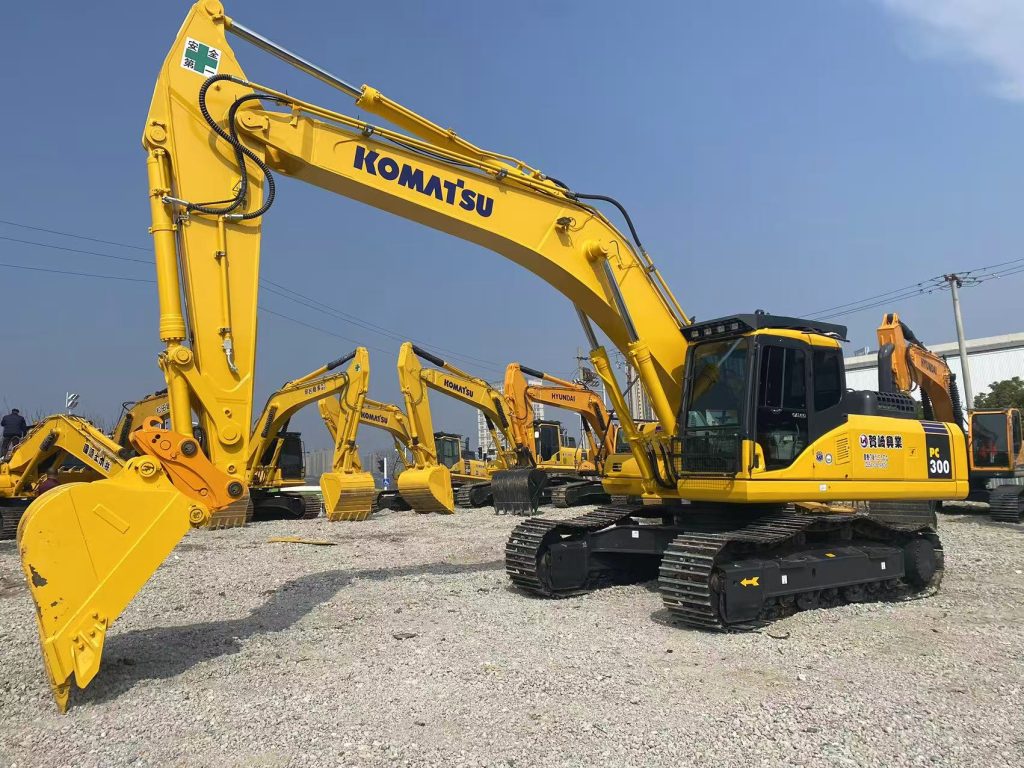A la hora de elegir entre la PC300 y la PC200, aquí tienes una comparación que te ayudará a decidir cuál es la más adecuada para proyectos de construcción de gran escala y de medianos a pequeños:
1. Desempeño y capacidad laboral
Komatsu PC300: Como excavadora de tamaño mediano a grande, la PC300 es ideal para proyectos de construcción a gran escala, como grandes movimientos de tierra, operaciones mineras y grandes proyectos de infraestructura. Su mayor capacidad de trabajo la hace ideal para excavaciones profundas y amplias, así como para operaciones eficientes. Gracias a su motor más potente, puede realizar tareas más complejas y pesadas.

Komatsu PC200: La PC200, por otro lado, es más adecuada para proyectos de construcción medianos y pequeños, como desarrollo urbano, construcción de carreteras y obras de infraestructura a pequeña escala. Es muy eficiente para tareas como movimiento de tierras, dragado de ríos y demolición de edificios. Si bien su capacidad de trabajo no es tan alta como la de la PC300, sigue siendo muy eficiente para proyectos de menor escala.
2. Eficiencia de combustible y control de costos
PC300: Debido a su mayor potencia de motor y mayor capacidad de trabajo, la Excavadora Komatsu PC300 Suele consumir más combustible. En proyectos de gran escala, con largas jornadas de trabajo, el consumo total de combustible puede ser bastante elevado, lo que puede afectar los costos operativos a largo plazo.
PC200: En comparación, la PC200 ofrece una mayor eficiencia de combustible, lo que la hace más adecuada para proyectos de mediana y pequeña escala. A pesar de su menor capacidad de trabajo, si el tamaño del proyecto es moderado, el consumo de combustible es relativamente bajo, lo que ayuda a controlar los costos de construcción de forma más eficaz.
3. Adaptabilidad a los entornos de trabajo
PC300: La PC300 es ideal para condiciones de trabajo difíciles, como excavaciones profundas, entornos fangosos y grandes movimientos de tierra. Su estabilidad y capacidad de trabajo son especialmente útiles en entornos complejos, especialmente para operaciones de larga duración y alta intensidad.
PC200: La PC200 es más adecuada para obras urbanas o rurales típicas, donde tareas como pequeños movimientos de tierra, manipulación de piedra y construcción de infraestructura son comunes. Es versátil y se adapta a diversos entornos, pero puede no ser tan eficiente para tareas pesadas como grandes movimientos de tierra o la manipulación de materiales muy pesados.
4. Mantenimiento y reparaciones
PC300: Debido a su mayor carga de trabajo, la PC300 puede requerir mantenimiento y reparaciones más frecuentes, especialmente en condiciones de alta intensidad de operación. Las piezas de repuesto pueden desgastarse más rápido y el tiempo de inactividad por reparaciones podría afectar los plazos del proyecto, especialmente en proyectos de gran envergadura.
PC200: Mientras que el Excavadora Komatsu PC200 Es menos potente y suele tener menores costos de mantenimiento y reparación. La longevidad de sus componentes es mayor y el tiempo de inactividad es mínimo. Es ideal para proyectos que requieren operación frecuente, pero a menor escala, donde las necesidades de mantenimiento son más manejables.

5. Comodidad y manejo del operador
PC300: Al ser una excavadora de mayor tamaño, la PC300 ofrece mayor potencia y estabilidad durante la operación, lo que facilita al operador la gestión de cargas de trabajo pesadas. La cabina del operador es más espaciosa y su interfaz es moderna, lo que la hace cómoda para trabajos largos e intensos.
PC200: Si bien no es tan potente como la PC300, la PC200 ofrece excelente maniobrabilidad y comodidad, lo que la hace ideal para proyectos de mediana a pequeña escala que requieren movimientos y reposicionamientos frecuentes. La cabina está diseñada para largas jornadas de trabajo, ofreciendo una buena comodidad a los operadores.
Conclusión:
Para proyectos de construcción a gran escala: Si el proyecto es de gran envergadura, con excavaciones profundas y movimiento de tierras pesado, la PC300 es la opción más adecuada. Ofrece mayor capacidad de trabajo y estabilidad, capaz de realizar diversas tareas complejas en entornos exigentes.
Para proyectos de construcción medianos y pequeños: Si el proyecto implica desarrollo urbano, construcción de carreteras u otras tareas menores, la PC200 es la mejor opción. Ofrece mayor eficiencia de combustible, es más rentable y eficiente para las operaciones diarias, especialmente en entornos que requieren flexibilidad.
